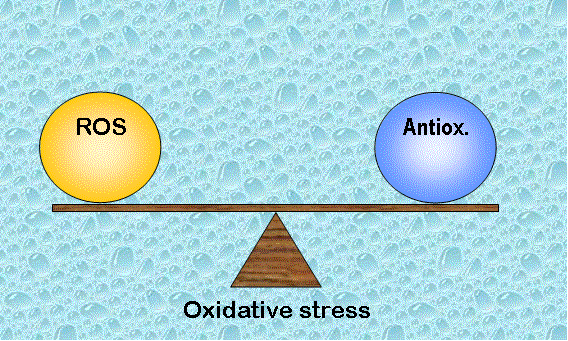 Research
group:
Research
group:
Free Radicals and Oxidative Stress in Human Physipathology
Department of Physiology
Medicine and Nursing School. University of the Basque Country, UPV/EHU
About us
Free radicals
The research interest of our group is focused on Free Radicals and Oxidative Stress, which are increasingly important in the onset and development of human diseases. The organism satnds in a balance between pro-oxidants and antioxidants (redox balance), so that when the production of free radicals and other reactive species increases, this equilibrium is upset, resulting in a condition known as oxidative stress. This state can be the origi of numerous diseaeses such as coronary heart- and neurodegenerative diseases, cancer, drug toxicity, infertility and the ageing process itself. It is, therefore, useful to develop both biochemical and genetic tools to detect oxidative stress markers, which may be associated with the disease.

|
Free radicals and reactive oxygen species (ROS) in normal aerobic life
Imbalance in the oxidants/antioxidants status
|
|
Oxidative stress in human pathophysiology
|
Lines of interest ● Biomarkers of oxidative stress in vivo
● ROS and infertility ● ROS, natural antioxidants, and antitumoral response |

We are interested in:
- The development of oxidative stress biomarkers in vivo
One of our priorities is to develop both biochemical and genetic methodological tools to detect oxidative stress markers, which could be associated with the disease.
- The role that free radicals and oxidative stress have in human infertility
Free radicals/reactive oxygen and nitrogen species (RONS) and antioxidants are involved in the regulation of reproductive processes (luteal cycle follicular development, ovulation, fertilisation, embryogenesis). Minor variations in the redox balance can trigger RONS-mediated signaling, which regulates these processes. However, high RONS levels produce oxidative damage, originating obstetric complications. To conceive it is necessary to strictly control the components of this balance (RONS versus antioxidants). The redox state and the lipid composition of follicular fluid are critical in oocyte development and maturation, and, therefore, will determine the success of in vitro fertilization (IVF). We are interested in determining the antioxidant status of follicular fluid, the lipid composition (lipidome) and the degree of expression of antioxidant enzymes in follicular granulosa cells for defining markers of fertility and dysfunction in women undergoing ovarian stimulation cycles in IVF programs.

- ROS, natural antioxidants and antitumoral response
In addition to their harmful effects, free radicals and other reactive species possess functions of defense against foreign substances that invade our bodies, and also act as messengers in cell signaling processes. Because of this signaling function, our cells can adapt to stress external stimuli, so that, for example, we can withstand the exposure to a toxic agent for longer, or a higher concentration of the toxic. In this context, free radicals can also cause activation of signaling cascades that lead to programmed cell death (apoptosis). We have seen in previous studies that doxorubicin, an antitumor agent that generates free radicals, induced intracellular signaling in primary cultures of rat hepatocytes. It triggered the activation of protein kinases and transcription factors causing changes in the expression of specific genes and cell death by apoptosis. We are investigating the signaling mechanisms that doxorubicin induces in these untransformed cells and whether this transduction pathway is different in tumor cells.
Tumor and inflammatory processes, which are closely linked, are subjected to modulation by the redox state of the cell and its microenvironment. Considering that medicinal plants possess bioactive components with antioxidant activity and the ability to alter RONS generating/scavenging system activities, their use will imply alterations in cell signaling affecting growth, migration and invasion of the tumor. We are studing the antioxidant and antitumoral actions of different plant extracts in various cell lines. The objective of this line is to establish the anti-tumor and anti-inflammatory activities of extracts from plants used in traditional medicine and herbal therapies and characterise the intracellular signaling induced in human tumor cell lines.
Colaborations
- Department of Physical-Chemistry, UPV/EHU.
- Cruces Hospital, Department of Obstetrics and Gynecology. Cruces, Spain.
- IVI-Bilbao clinic, Vizcaya, Spain.
- University of Jaén. Department of Medical Science. Jaén, Spain.
- Institut National de la Reserche Agronomique (INRA), Toulouse, France.
- University of Burdeaux, France.
- A. Mira de Béjaia University , Argelia.
- University of Amazonía, Colombia.
Technological offer
- Application of molecular and cellular biology techniques to the study of intracellular signaling.
- Application of techniques of molecular and cellular biology (cell cultures) in studies of cytotoxicity.
- Quantification of biomarkers of oxidative stress in biological samples and in body fluids by HPLC, ELISA, gas chromatography, spectrophotometry and fluorimetry.
- Determining polymorphisms (SNPs) of antioxidant genes and genes involved in oxidative metabolism.
- Lipidomic analysis of biological samples.
- R & D projects of collaboration related with the research lines of the group.
